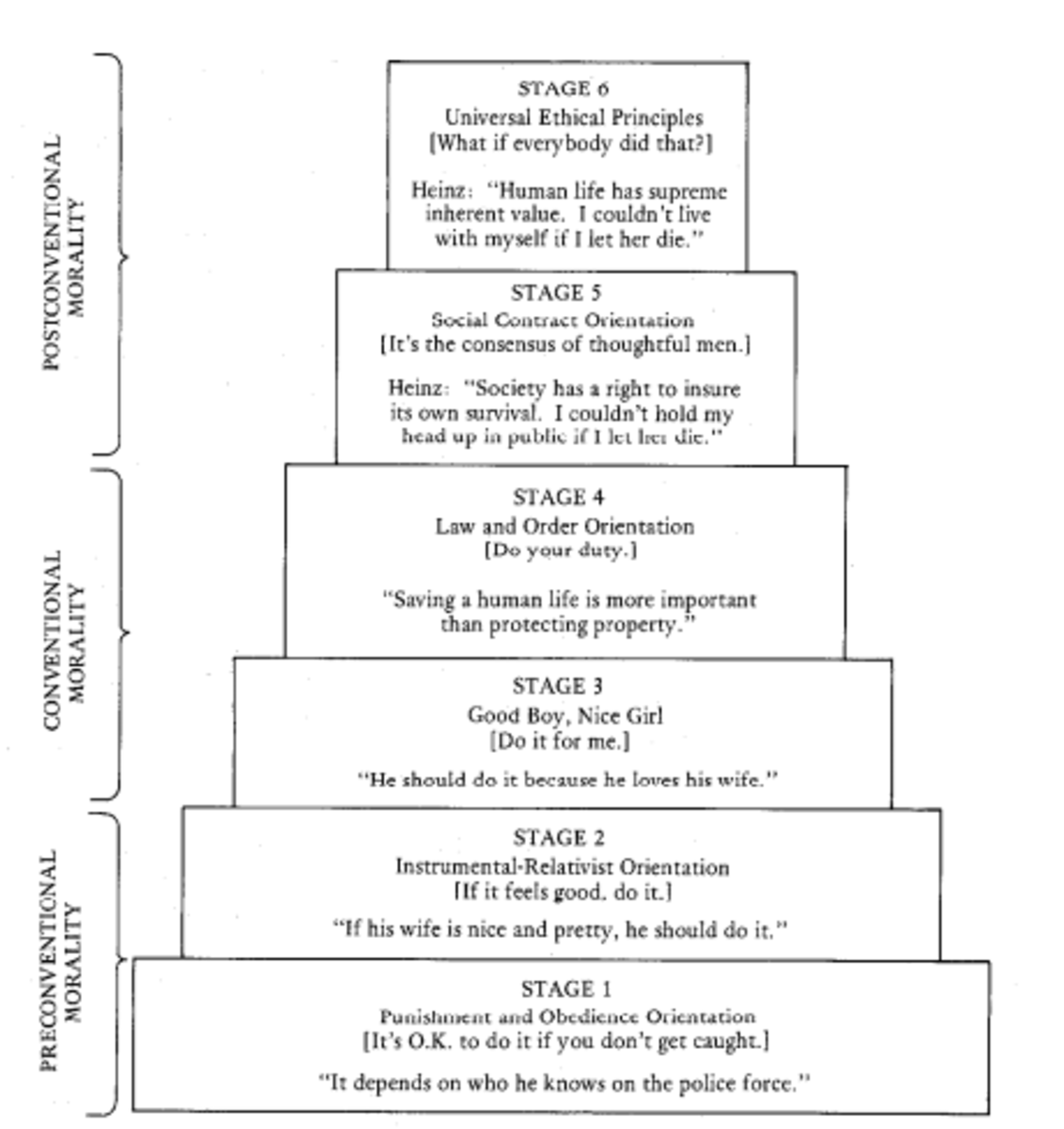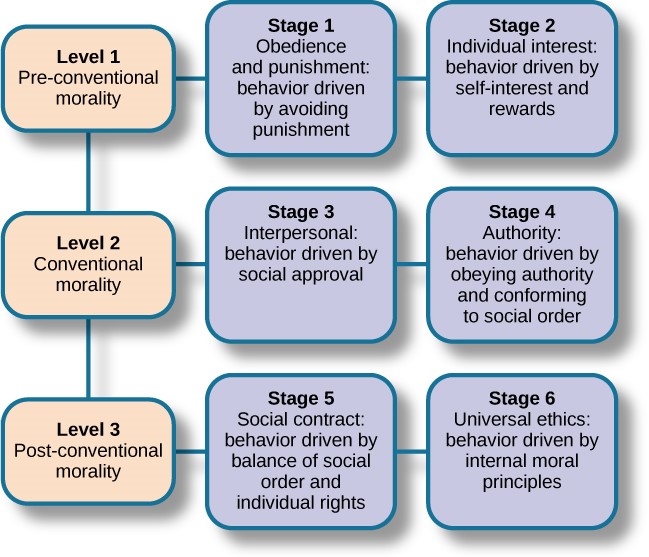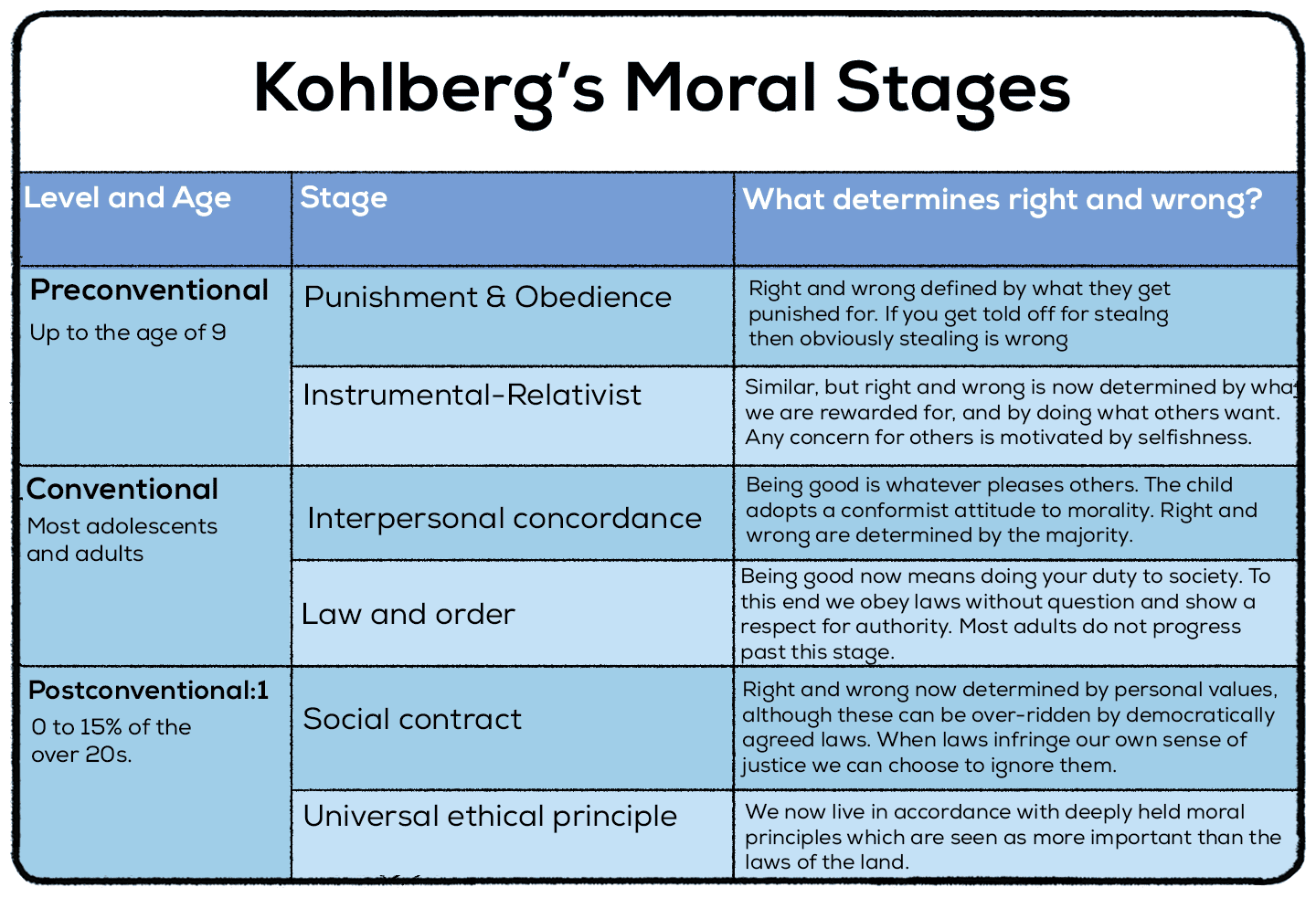
Kohlberg’s Theory of Moral Development Stages & Examples (2023)
Kohlberg - gewetensontwikkeling. Lawrence Kohlberg. (1927 - 1987) Kohlberg raakte tijdens zijn psychologie-opleiding geïnteresseerd in de morele ontwikkeling. In die tijd waren Freuds theorie en die van de behavioristen op dat gebied dominant, maar ze spraken hem niet aan.

Kohlberg's Stages of Moral Development Download Scientific Diagram
Kohlberg's theory of moral development is a theory that focuses on how children develop morality and moral reasoning. Kohlberg's theory suggests that moral development occurs in a series of six stages and that moral logic is primarily focused on seeking and maintaining justice. Here we discuss how Kohlberg developed his theory of moral.

Kohlberg's Stages of Moral Development
Kohlberg's levels of moral development are as follows: The Preconventional level: children accept the authority (and moral code) of others. If an action leads to punishment, it must be bad. If it leads to a reward, it must be good. There is also a sense in which decisions concerning what is good are defined in terms of what is good for us.

Kohlberg's stages of moral development ladder
Based on tape recorded interviews with groups of boys aged 10, 13, and 16, in which hypothetical moral dilemmas were presented, a sequence of moral development is worked out. 6 types or modes of thought were patterned out, the 2 less mature decreasing with age while the 4 more mature modes increased with age. The interpretation of the findings is that "these types of thought represent.

PPT Kohlberg’s Stages of Moral Development PowerPoint Presentation ID2526410
Lawrence Kohlberg, (born October 25, 1927, Bronxville, New York, U.S.—died January 17, 1987, Boston, Massachusetts), American psychologist and educator known for his theory of moral development.. Kohlberg was the youngest of four children of Alfred Kohlberg, a successful silk merchant of Jewish ancestry, and Charlotte Albrecht Kohlberg, a Protestant and a skilled amateur chemist.

Cómo aplicar la teoría del desarrollo moral de kohlberg en el aula como profesor Academia 2023
This chapter revisits, clarifies, and critiques Kohlberg's theory. We conclude with a new view of "the right" in moral development. The basics of this view were introduced in our Chapter 3 depiction of the fundamental themes of the cognitive-developmental approach: themes such as growth beyond the superficial, construction, social perspective-taking, and stage sequence.

5. De Kleuter
Kohlberg's Model of Moral Development Level 1 (Pre-Conventional) 1. Obedience and punishment orientation ( How can I avoid punishment?) 2. Self-interest orientation ( What's in it for me?) ( Paying for a benefit) Level 2 (Conventional) 3. Interpersonal accord and conformity ( Social norms) ( The good boy/girl attitude) 4.

Theories of Moral Development Adolescent Psychology
The Psychology of Moral Development: The Nature and Validity of Moral Stages. By Lawrence Kohlberg. San Francisco: Harper & Row, 1984. xxxvi + 729 pages. 33.00. - Volume 12 Issue 2

Morele ontwikkeling van Lawrence Kohlberg lesblok I Pre conventioneel niveau Type 1 het kind
Oorspronkelijk was Kohlberg geïnteresseerd in de ontwikkeling van het individuele morele besef. Echter, toen bleek dat de relatie tussen het individuele morele besef en normoverschrijdend gedrag zwak was bij scholieren, verlegde hij zijn aandacht naar het morele klimaat van de omgeving.

Kohlberg’s Stages of Moral Development (6 Stages + Examples) Practical Psychology
De morele ontwikkeling van kinderen volgens Kohlberg | Mens en Samenleving: Pedagogiek De morele ontwikkeling van kinderen volgens Kohlberg De morele ontwikkeling van een kind is erg belangrijk. Kohlberg (1929-1987), een Amerikaanse ontwikkelingspsycholoog, heeft deze ontwikkeling onderzocht.

Kohlberg's Six Stages of Moral Development YouTube
Kohlbergs theorie over morele ontwikkeling is een fundamenteel raamwerk op het gebied van psychologie en ethiek. Deze theorie, ontwikkeld door Lawrence Kohlberg in de jaren vijftig en zestig, probeert uit te leggen hoe individuen hun morele redenering ontwikkelen en ethische beslissingen nemen terwijl ze de verschillende stadia van cognitieve en morele ontwikkeling doorlopen. De grondslagen.

5. De Kleuter
De centrale stelling van Kohlberg (1984) luidt dat de ontwikkeling van morele oordeelstructuren universeel is, inhoudende niet afhankelijk is van culturele factoren, geslacht, sociale klasse en dergelijke. Voorts stelt hij dat deze noodzakelijk en in volgorde verlopen via een zevental stadia. Kritisch hierbij is dat het indelingscriterium voor.
/kohlbergs-theory-of-moral-developmet-2795071_final2-561cb59661404f3e8ac95ce201dc8463.gif)
Kohlberg's Theory of Moral Development
Lawrence Kohlberg werd geïnspireerd door het werk van Jean Piaget over moreel oordeel om een stadiumtheorie van morele ontwikkeling in de kindertijd te creëren. De theorie omvat drie niveaus en zes stadia van moreel denken. Elk niveau omvat twee fasen.

PPT Kohlberg’s Theory of Moral Development PowerPoint Presentation ID2837760
Kohlberg ontwikkelde, geïnspireerd door het genetisch structuralisme van Jean Piaget, een model voor de morele ontwikkeling van kinderen en volwassenen. Gedurende de morele ontwikkeling doorloopt een mens verschillende stadia in een vaste volgorde. De eerste stadia die doorlopen worden betreffen de meest basale normen.

In deze mindmap staat de morele ontwikkeling volgends de theorie van meneer Kohlberg. Het is
Oorspronkelijk was Kohlberg geïnteresseerd in de ontwikkeling van het individuele morele besef. Echter, toen bleek dat de relatie tussen het individuele morele besef en normoverschrijdend gedrag zwak was bij scholieren, verlegde hij zijn aandacht naar het morele klimaat van de omgeving.

Morele ontwikkelingstheorie van Lawrence Kohlberg YouTube
"Bibliography of writings by Lawrence Kohlberg": pages 710-716 Includes bibliographical references (pages 684-709) and index pt. 1. Moral development theory -- Stage and sequence : the cognitive-developmental approach to socialization -- Moral stages and moralization : the cognitive-developmental approach -- pt. 2.